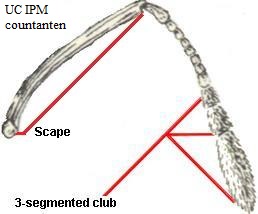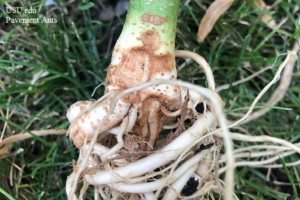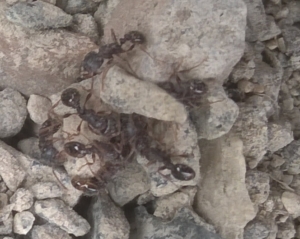The Ant Rant
The Ants Go Stinging One By One, Hurrah, Hurrah??
Ants exploded out of the gravel and dashed in all directions. In no time many scurried up my glove and onto my skin, blasting formic acid from bottom of their butts. Trying to solve an irrigation problem, I had disrupted an ant colony. Later, my skin showed many red sores with raised centers, like nipples. The discomfort lasted a day or two. I decided to find out just who these ants were, at least at the genus level.
 Whenever I research some new topic, the new vocabulary makes me think of scrabble: scape, clypeal, gaster, and acidopore. A microscope is needed to match the body parts with the description of a particular ant genus, e.g., count the antenna segments and determine whether there is a club at the end and whether the club has two or three segments.
Whenever I research some new topic, the new vocabulary makes me think of scrabble: scape, clypeal, gaster, and acidopore. A microscope is needed to match the body parts with the description of a particular ant genus, e.g., count the antenna segments and determine whether there is a club at the end and whether the club has two or three segments.
My unscientific conclusion is that the ants at FECO were pavement ants
(Family – Formicidae, Subfamily – Myrmicinae, Genus – Tetramorium).
The Ants Go Stealing Two By Two, Hurrah, Hurrah??
You can wear gloves, long sleeves and pay attention to avoid stings but how to prevent seed, small plants and even seedling theft?
To make certain the seeds of the Yampah (Periderdia spp.) plant fell into my hands, I carefully wrapped row cover around a seed head. A week later I opened up the row cover and ants started moving lickety-split in every direction. They had already carted off all of the seeds! It wasn’t the first time this year that seeds have been confiscated. Nice small carrot seeds were hauled away earlier this year, under observation! How do the ants get the food back to their colony?
for work parties
Sat. Oct 19, 1-4 Cider Fest!
Please email to volunteer
freewayestatescommunityorchard@gmail
The Ants Go Feasting Three By Three, Hurrah, Hurrah??
Workers find food and then ring the dinner bell through the use of pheromones. (Perhaps this is why some gardeners use black pepper or cinnamon to ward them off.) Groups of workers can process large food items and tote them back to the colony. Direct homing has been documented in worker ants of the Tetramorium genus. Based on a reference light source and an awareness of the direction and distance they have traveled, pavement ants can calculate a straight-line path back to their colony while carrying food! (Shen et al. 1998)
The Ants Go Helping Four By Four, Hurrah! Hurrah!
Now then, let’s not be one-sided. Many .edu websites repeat the same kind words. “The pavement ant may also be an important ecosystem service provider in urban environments, by dispersing seeds, aerating soil, and recycling nutrients. They can also be a source of food for birds, reptiles, and other wildlife, helping to enrich the local eco-system.”
The Ants Go Harming Five By Five, Hurrah, Hurrah??
Here are a few more downsides to these non-native pavement ants:
Although they’re mostly scavengers, ants can feed on tender shoots, seedlings, and other vulnerable plants. (Indeed. They ate all of my tiny common camas (Camassia quamash ssp. quamash) bulbs this spring! A whole ant colony was nearby, underneath a large stepping stone.)
They snack on sweeter parts of a plant including fruits, flowers, and even sugar-rich vegetables.
Although ants often help pollinate flowers, they can also do the exact opposite and ‘steal’ pollen. This is more of a problem with plants that have separate male and female flowers, especially when the flowers are spaced a distance apart, such as squash.
Ants notoriously ‘farm’ honeydew-producing pests, such as aphids, leafhoppers, whiteflies, mealybugs, psyllids, and soft scale insects, protecting and spreading these pests.
Ants tend to build their underground nests around root systems. The excavated space deprives the parent plants of water and nutrients, stunting growth.
Pavement ants may competitively exclude native ants from urban environments (Lessard and Buddle 2005).
Well, I wouldn’t fumigate the garden, but be sure to wear proper clothing around ant colonies. Also,  make sure none are crawling around in your bag when you get home. You do not want them to know your address! Finally, protect those seeds of plants that you hope to propagate.
make sure none are crawling around in your bag when you get home. You do not want them to know your address! Finally, protect those seeds of plants that you hope to propagate.
Ruth
——-
Notes:
Pavement ants were introduced to the USA from Europe, likely in the 1700s to 1800s.
Common native ants in Washington State are:
Thief ants (Solenopsis molesta) – small, all over US
Carpenter ants (Camponotus ssp.) – C. modoc more common than C. vicinus
Odorous House Ants (Tapinoma sessile) – all over US
Velvety Tree Ants (Liometopum occidentale L. luctuosum)
Red-winged ant (Manica hunteri) – more up in the mountains
Fuzy mound ant (Formica lasioides) – native all across northern US
Thatching ant (Formica ravida) – western US, not so urban
Western Thatching ant (Formica obscuripes) western US
Three most common ants in Washington State:
Odorous house ants or sugar ants (Tapinoma sessile)
Carpenter ants (C. modoc more common than C. vicinus)
Pavement ants (Tetramorium ssp.)
Resources:
Key to Subfamilies of North America
many authors, many dates, Ant Wiki
https://www.antwiki.org/wiki/Key_to_Subfamilies_of_North_America
Identification and Habits of Key Ant Pests of Washington
Laurel Hansen, no date, Washington State University, Department of Entomology
“https://s3.wp.wsu.edu/uploads/sites/415/2014/12/antpests.pdf”
Integrated Pest Management for Ants in Schools
Tim Stock, 2022, Oregon State University Extension Service
https://extension.oregonstate.edu/catalog/pub/pnw-761-integrated-pest-management-ants-schools
Pavement ant Tetramorium caespitum (Linnaeus) (Insecta: Hymenoptera: Formicidae)
Tyler Vitone, Sept 2014, University of Florida
“https://2arrestapest.com/wp-content/uploads/2016/04/IN104700.pdf”
Pacific Invasive Ant Toolkit (PIAT) – Identification
Eli Sarnat , 2016, Antwork Consulting, LLC
https://piat.org.nz/index.php?page=identification#basic
Key to Identifying Common Household Ants
no author, no date, UC IPM
https://ipm.ucanr.edu/TOOLS/ANTKEY/KEY_PAGES/nodes.html
The Biochemical Toxin Arsenal from Ant Venoms
Axel Touchard, 2016, Toxins
https://www.ncbi.nlm.nih.gov/pmc/articles/PMC4728552/
Impact of invasive ant species on native fauna across similar habitats under global environmental changes
Siddiqui, 2021, Environmental Science and Pollution Research
“https://antwiki.org/wiki/images/f/ff/Siddiqui%2C_J.A.%2C_Bamisile%2C_B.S._et_al._2021._Impact_of_invasive_ant_species_on_native_fauna_across_similar_habitats_%2810.1007%40s11356-021-15961-5%29.pdf”
The effects of urbanization on ant assemblages (Hymenoptera: Formicidae) associated with the Molson Nature Reserve, Quebec
Lessard, 2005, The Canadian Entomologist
https://www.researchgate.net/profile/Jean-Philippe-Lessard-2/publication/232251071_The_effects_of_urbanization_on_ant_assemblages_Hymenoptera_Formicidae_associated_with_the_Molson_Nature_Reserve_Quebec/links/58fe4ec80f7e9bcf6543ffae/The-effects-of-urbanization-on-ant-assemblages-Hymenoptera-Formicidae-associated-with-the-Molson-Nature-Reserve-Quebec.pdf?origin=publication_detail&_tp=eyJjb250ZXh0Ijp7ImZpcnN0UGFnZSI6InB1YmxpY2F0aW9uIiwicGFnZSI6InB1YmxpY2F0aW9uRG93bmxvYWQiLCJwcmV2aW91c1BhZ2UiOiJwdWJsaWNhdGlvbiJ9fQ
Ants affect citrus pests and their natural enemies in contrasting ways
Diego V. Anjos, March 2021, Biological Control Volume 158, July 2021, 104611
https://www.sciencedirect.com/science/article/abs/pii/S1049964421000815



Very interesting, Ruth!
Thankfully, we don’t see many ants outside.. Occasionally, they’re a problem indoors, however. None today though!